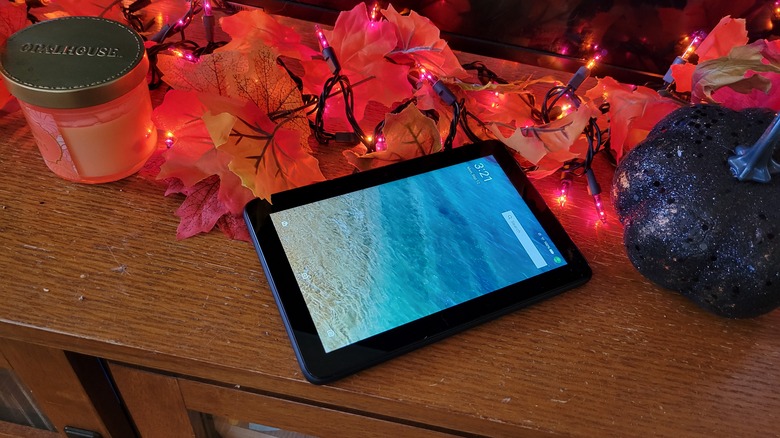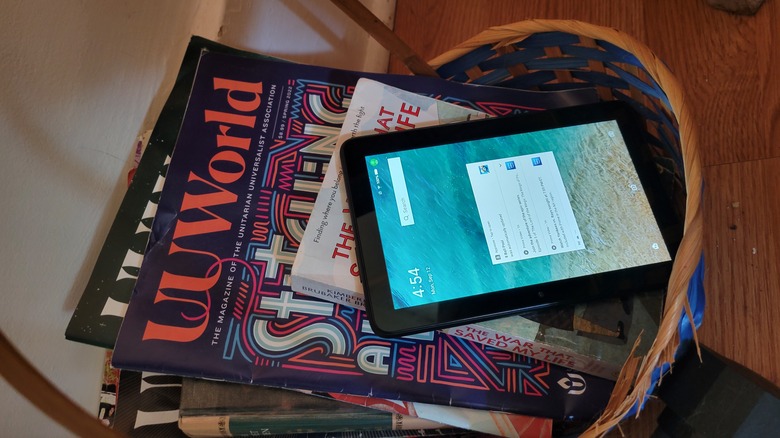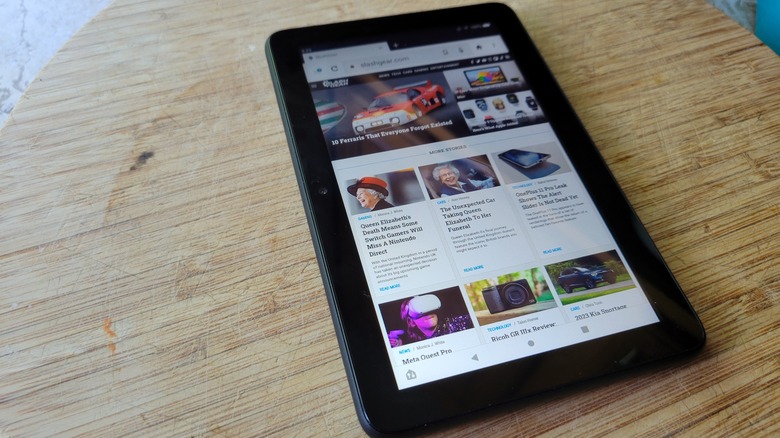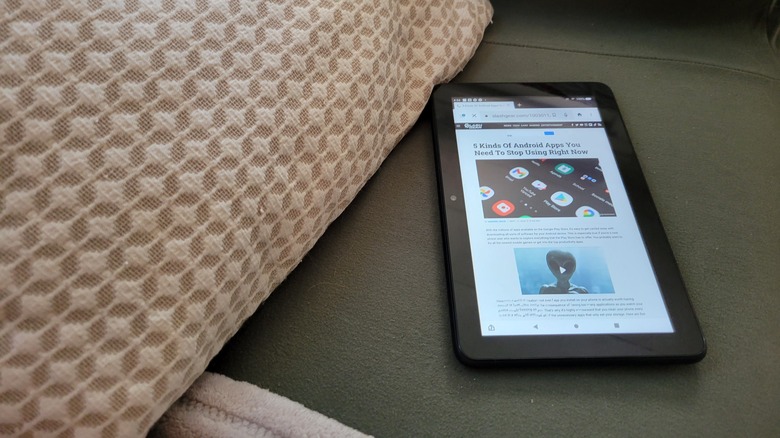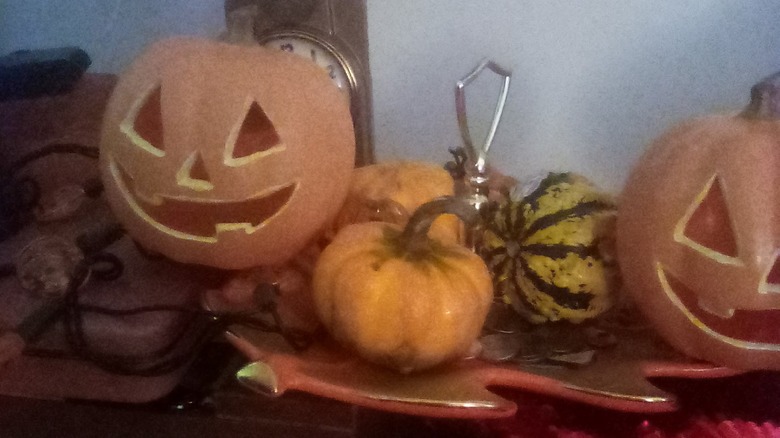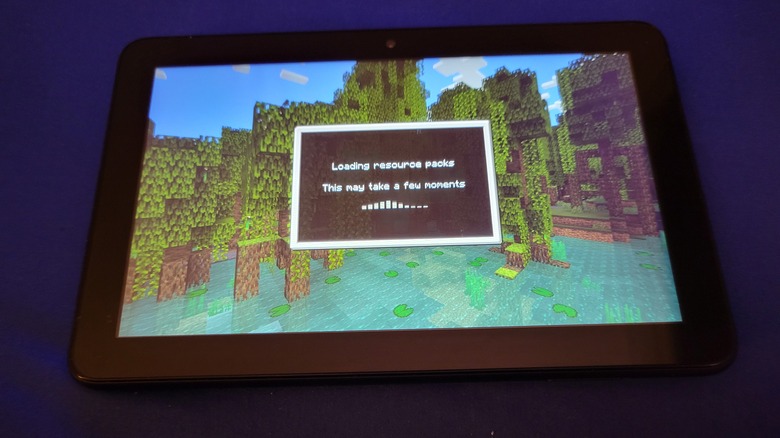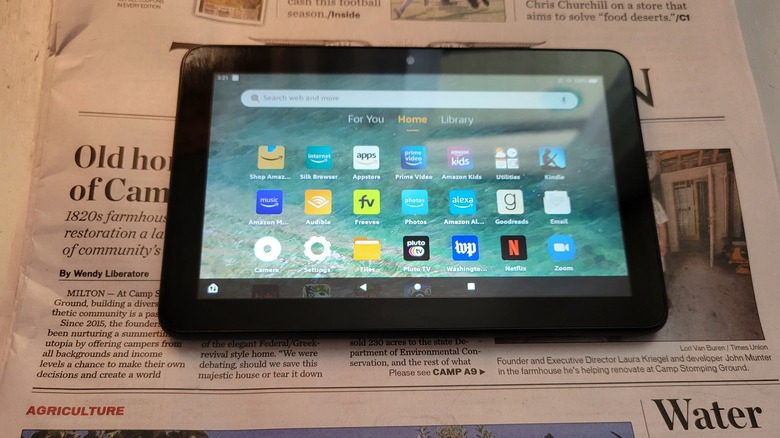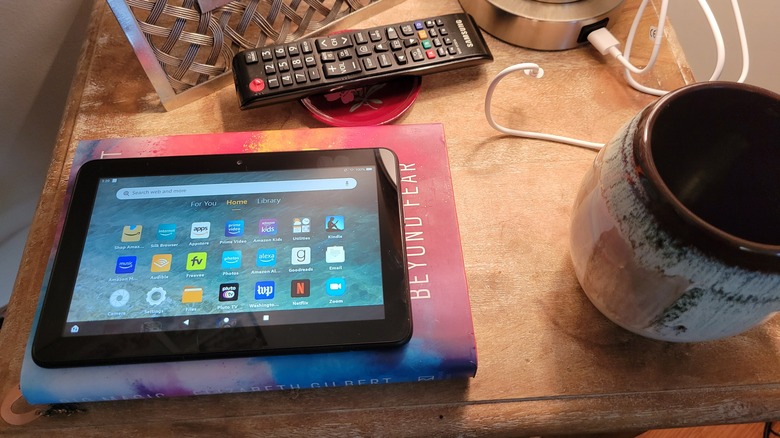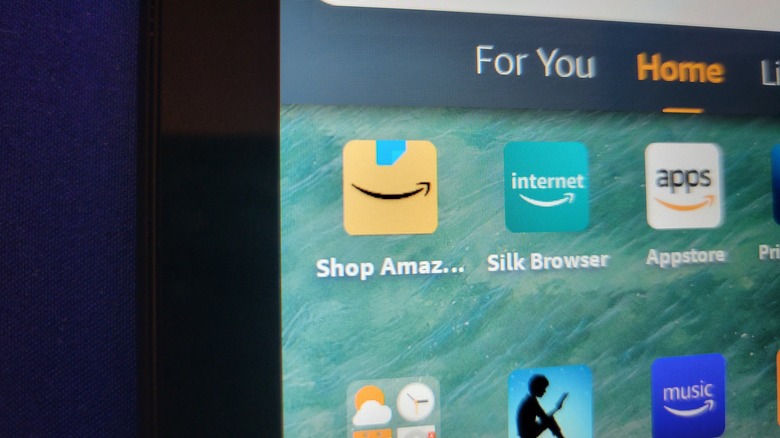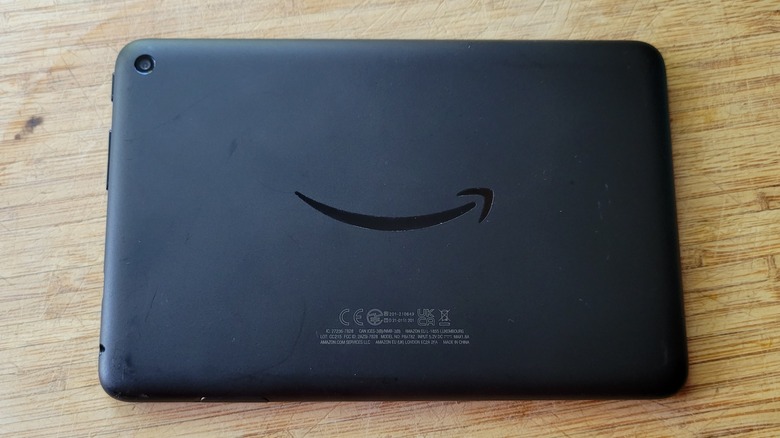The Amazon Fire 7 Tablet: You Get What You Pay For
- Very low price
- Light and comfortable to hold
- Good battery life
- Very underpowered
- Limited to Amazon's app store
- The camera and speakers are awful
- Poor accessibility options
Amazon has a wide array of devices at low price points. Some of these devices are pretty good — Alexa is a perfectly adequate smart home system, Fire TV is a nice home entertainment centerpiece, and the Kindle has pushed the popularity of e-Readers to a whole new level. So what about Amazon's attempt to corner a chunk of the tablet market?
Starting with the positives, the Amazon Fire 7 can be very cheap. If you time it correctly, the Kindle Fire 7 is available at a startlingly low price. Simply wait one of Amazon's major sale periods, and you can pick the edition with 16 GB of storage up for $59.99 or pay $79.99 for the 32 GB version. But let's be honest, Amazon's in-house products are like Domino's Pizza. Nobody pays the sticker price for them. Just wait for Prime Day, Black Friday, or even a random weekend in March, and you'll see up to 55% knocked off the Fire 7's list price. At that point, it may be worth taking a gamble on. It is also worth noting you can expand the tablet's storage up to a terabyte with a micro SD card.
There's both a version with ads and an ad-free edition. Amazon does this with several of its devices these days. You have three colors to choose from: black, denim (blue), and rose (pink). Amazon's tablet has 2 GB of RAM, double what the previous version had, a "30% faster processor," and up to 10 hours of battery life. It boasts a wide selection of apps and plays well with its own services — including Amazon Kids and Kindle. But how does it really hold up?
The Fire 7 is pretty portable
Amazon's 7" tablet is a good size. You can comfortably hold it one-handed, it's light, and it can conveniently fit in a small bag, purse, or a particularly large coat pocket. This has two big benefits, the first being portability, and the second comfort. Like its black and white relative, the Kindle, the Fire 7 has a solid form factor for reading-based tasks. I found myself reading the news on it every morning because it's a handy size.
The battery life is also pretty good. In standby mode, it can last over a week, and with continuous use, you should be able to get a working day out of it. All of this means carrying the Fire 7 around with you is a feasible idea and makes sense if you enjoy a larger screen, Amazon's services, or just want to take some of the burden from your smartphone's battery. The other portability-related question is, can this tablet take a knock? Its lightweight plastic construction makes it pretty durable. I've definitely dropped it from a desk or two during my time with it, and the Fire 7 survived the experience unscathed. Obviously, if you touchdown spike it onto concrete, it's going to explode. But it is durable enough to survive most travel-related accidents.
Accessibility may be an issue
Given the device's price point, lightness, and basic operating system, you may be tempted to purchase one for an elderly relative. This is a great idea, in theory; the Kindle allows access to the internet, provides several entertainment options, including YouTube, and can double as a Kindle. That said, the device is also a bit inaccessible.
If you go to the accessibility menu, there are two options for people whose eyesight needs a little help. One is ramping up the font size, and another adds the ability to magnify portions of the screen if you need a closer look. Both of these are good ideas that are executed rather poorly.
With font size, you get four options, and the largest option is still far too small. There's no reason a larger text option couldn't be added — most Android phones have far smaller screens and you can ramp the text size up much further on those. Then there is the zoom option, which is again a good idea in theory but one that has been poorly executed. To bring the magnification box up you need to double tap the area of the screen you want to zoom in on. This is a simple gesture for a 30-year-old but might be near impossible for someone whose dexterity has been tested over seven or more decades on the planet. Then, when the zoom box is up, there's the scrolling option. This is awful even if your hands are in perfect working order. You need to use two fingers, the movement isn't smooth, and the whole thing just feels incredibly janky. If you want to ease granny into the world of tech and are eyeing up a Kindle, please don't bother. The old dear has probably suffered enough without piling on this piece of misery.
The touchscreen isn't bad
Visually, the Fire 7 screen isn't bad at all. It isn't a super OLED or anything, but you would have to be a certain type of person to obsess over how black the blacks really are on a $60 tablet. In terms of definition, you don't need to be 4K capable to make a 7-inch screen look good, and the screen they've slapped onto the Fire 7 is just fine. If you're using this to watch a few videos or some TV while traveling, you won't be too disappointed. Where it lets itself down is the audio. If you honestly want to enjoy a movie or show on this tablet, you'll need to jam some headphones into the 3.5mm jack or connect them via Bluetooth. The speakers on this thing are tremendously awful — the sort of tinny garbage you'd expect to hear from a dollar store radio.
As far as the touchscreen's responsiveness goes, it's pretty good. Some of the gestures may require a bit of finesse before they're recognized every time, but the Fire 7 responsively and accurately detects the prodding and swiping that makes up 99% of tablet use. While this is a plus, it's also not too impressive. It's been a while since I've had to deal with a truly bad touchscreen, even on entry-level devices.
It has two cameras, but Amazon shouldn't have bothered
You can use the Amazon Fire 7 to video call friends and relatives, and Amazon is pretty proud of this feature. It's listed as one of the device's big plus points on the Fire 7's store page, and they've gone as far as to slap two cameras on the tablet itself. As with most devices, there's a front-facing "selfie" camera and a rear "main" camera. In theory, the front-facing one is ideal for video calls and selfies, while the rear camera is meant for higher-quality photos and as a way to show people on video calls what you're seeing.
The trouble is, both cameras are bad. Really bad. Like, early 2000s flip-phone camera bad. As you can see from the picture above, the image quality leaves a lot to be desired, and you probably won't be snapping anything "gram-worthy" with it. If you do take a selfie with this thing and upload it to social media, people may think you've discovered time travel.
The pictures it produces are awful in ideal conditions and utterly horrendous in anything resembling low light. The cameras attached to this device are so low-quality that I'd argue Amazon would have been better off selling a cameraless device for $2 cheaper. In addition to the low-resolution images they produce, the front-facing camera fails to offer modern features like face unlock. Between the image quality and the audio, the Fire 7 certainly shouldn't be your go-to video call device. To put a cherry on the cake, the camera app itself is a pain to use. Switching between the cameras involves tapping an options ellipsis then a switch camera symbol without any cameras on it.
If you like using a tablet for gaming, swerve the Fire
Just to get this out of the way, despite the fact they've probably released a version designed to run on a toaster oven, Fortnite does not seem to be available on the Amazon Fire 7. Roblox is, but rather than enter that hell, I opted for Minecraft and New Star Soccer to test out the device's gaming capabilities. Minecraft runs. Everything takes an absolute age to load, and like all other touchscreen editions of Minecraft, the controls are awful, but it does work. That's probably one of the more advanced games you'll find on the Kindle 7's store.
If more basic and casual games are your thing, you'll have no problem with the Fire 7. Games like Bejeweled, solitaire, and those million tower defense/base building pay-to-win mobile games all run flawlessly. If you need a device to quarantine this kind of game, so your phone isn't constantly pinging and trying to lure you into more microtransactions — the Fire 7 is probably ideal.
Your apps may be neglected
New Star Soccer also runs and taught me more about gaming on the Kindle than I ever believed it would. It's just a little prod to play a soccer game; it's not very demanding at all. I initially picked it to see how the touchscreen responds in an environment where you have to prod things very precisely. However, the first thing I noticed was a bug on the character creation screen. Clicking the text boxes doesn't bring up the Fire 7's keyboard, so you can either link up a Bluetooth keyboard or be stuck with the default name forever.
When I eventually got in, I noticed the Amazon version of the game is pretty old. There are features the iOS, and Android versions got around 10 years ago that aren't present. Then it struck me that the Amazon store may be such a small section of the market developers simply don't bother with it. Things got worse when I tried to refund the broken, not updated in a decade, game. You can't. All Amazon app sales are final. You have companies like Steam where the refund policy is so generous people have speedrun a game in under two hours and gotten it refunded — then you have Amazon, where you can buy a broken, archaic version of an app and never see your $1.33 again. To rub some extra salt into the wound, I'm pretty sure the iOS and Android versions of this app are free.
The performance offered by the Fire 7 can be inconsistent
My video game-based testing period also included some time on Minecraft, which isn't the most demanding game in the world. It's over a decade old, the graphics aren't anything special, and although the game world is packed with objects and many things can be happening at the same time, you could probably optimize it to run on just about anything. And that's what Microsoft has been doing since they acquired the title back in 2014. In terms of performance, Minecraft runs on the Fire 7 perfectly well. However, you may want to connect a mouse and keyboard to the tablet as the touch screen controls make the game far more difficult to play.
While Minecraft may run perfectly well, the Android-based operating system the Fire 7 runs on doesn't. Even if you stick to light browsing, video viewing, and the occasional Kindle book — you'll frequently encounter noticeable lag and plenty of loading trouble. Again, Amazon's store app needs burning to the ground and rebuilding. It took four clicks before it registered that I wanted to download the Pluto TV app. Then when you exit an application, you might have to wait a few seconds for your apps to load back in. All of this was bad on a tablet several years ago, it just looks worse in this day and age.
The whole thing is one big Amazon ad anyway
At the risk of this turning into Amazon products in general review, I must warn you that one of the Fire 7's key functions is to sell you more Amazon products. The company's shopping app gets pride of place, and you'll frequently find yourself on a screen full of Kindle recommendations. Then there's the fact the device is $10 more expensive if you don't want banner ads shoving in your face every time you choose to use it.
This is really holding the FIre 7 back in more ways than one. A major issue comes with Amazon's decision to force customers to use its app store. This would be fine if the store had a decent refund policy, functional apps, and actually worked in the first place. Unfortunately, it has none of those things, and Amazon's customers have no other options. Samsung has its own devices, its own tweaked version of Android, and its own app store. Despite the fact Samsung's app store is perfectly functional, their phones also have Google's play store as an option. The version of Android the Fire 7 uses is also far less polished than other versions. For example, I had to take a photo with the device and email it to myself for this review. Using the "share" option in your gallery opens a new email but doesn't attach the file you've selected. Then, in yet another display of how much Amazon wants you to use its services, the "attach photo" option in a blank email opens Amazon photos, not the gallery on the device. The two hadn't synced when I went to send the image, so I had to attach the image in question as a "file."
It's an entry-level tablet in every way
Once again, I'll reiterate — this device is incredibly cheap. Comparing it to a premium tablet from Samsung or Apple is unfair, as they can cost as much as ten times what the Fire 7 sometimes goes for. But ultimately, you get what you pay for; this thing runs worse than a $150 phone. The little quality of life features the Fire version of Android is obviously lacking also take away from the experience massively. It's a bunch of small things you can work around, but both the OS itself and several apps in the store seem to be borderline abandonware. Amazon can boast about the processor being a touch faster, or RAM being added, but corner-cutting features like the camera and the janky software will make you think you've picked up a second-hand device that was released years ago. At the price, you probably won't feel hard done by if it winds up in a desk drawer and only comes out when you want to distract a house guest you're not fond of. But equally, there are better things to spend your money on.
The device itself is underpowered; basic things like the cameras and speakers are terrible, the app selection is limited, and the store you're forced to use for those apps is worse. There may be an argument for picking one of these up at a deep discount if you're looking for a beater tablet, backup device, or full-color Kindle alternative. However, if Amazon had these on sale and I had a spare $30 in my account, I'd probably just order a pizza instead.
